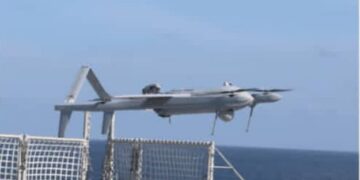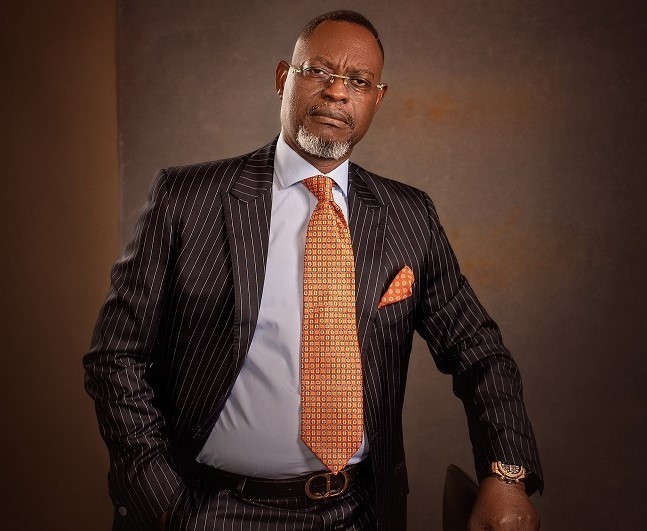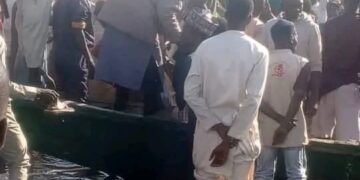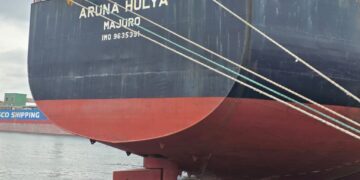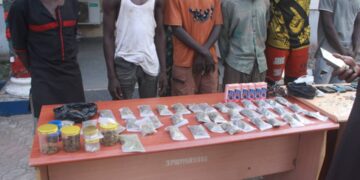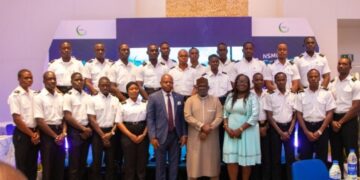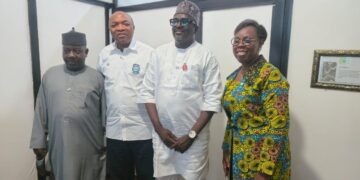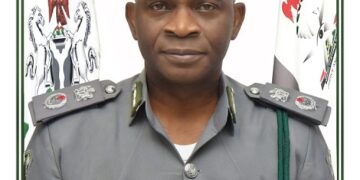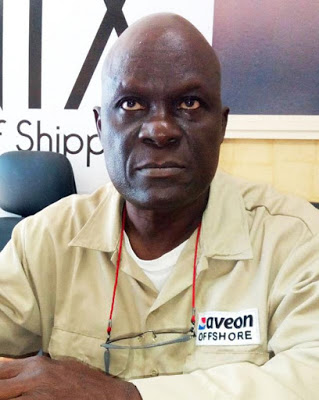On this maiden edition of our programme ‘Maritime History’, the Chairman/Chief Executive of Genesis Worldwide Shipping Ltd., Capt. Emmanuel Iheanacho, his staff at a time, Captain Jasper Ogbuagu, and Chief Engr. Chris Mbata, sit down to share memorable moments in the course of their many voyages, the storms they navigated and the sweetest feelings of surviving tough times!
Of course, it was a miraculous experience once when they faced water ingress into their ship MV Genesis Pioneer. Help came from an unexpected place and the ship was saved from sinking.
A second experience was at the Bay of Biscay! You only want to imagine what happened. Yet, they survived that storm again, and another experience in Canada.
It is a tale of many storms and subsequent survival!
What really happened on the MV Genesis Pioneer voyage sometime in 1996?
Miracles do happen, but they may also be prompted by some things.
This event happened in 1996 within the month of May, because of the Indian Monsoon, which used to be very rough. We left India heading to South Africa through the Cape of Good Hope, we have fashioned our course. As soon as we left the port, the weather changed to very rough Monsoon period and we started experiencing bad weather and the ship was pounding through the rough weather.
After two days into the journey the weather was still bad and we experienced there was a leakage in the forepeak tank. So, I had to alert the engineers. We had had to put in a submersible pump to evacuate the water that was ingressing into the forepeak tank. After two days into the journey the submersible pump failed, because it was pumping continuously when it was not meant to be. Then, I noticed that the ingress into the forepeak tank became slightly reduced because the first time I noticed it was rushing in and the pump was pumping continuously!
We were using our ballast pump to pump out the water from the forepeak initially. But the rate of the ballast pump pumping out water was not enough to cope with the ingress, so we had to introduce the submersible pump as an additional, and we found that the bow was still going down continuously.
So, after the submersible pump failed, the ingress reduced; that was about six to seven days into the journey and were had already plotted course to go through Madagascar. Yes, between Comoros and Madagascar. So, when we noticed that, we altered course, facing Africa to go and beach the ship. That was the decision, because the ingress was much.
The passage through Comoros was a bit far from the land and we thought that it might be better for us to go towards the coast, so if the border gets better, we can start heading back south. Usually, why we avoided going through the coastal passage was because of flick wave; there used to be flick wave from Madagascar up to South Africa. So, that was why we plotted our course to go through a bit offshore, more to Madagascar.
But when we noticed that we were having this problem, instead of going to sink at sea, let us beach the ship or let us go closer to the coast so we can manage. While this thing was going on, I noticed (Capt. Ogbuagu), because I was frequenting to the tank to know what was happening there.
What were your thoughts when you noticed the water ingress?
At that time our mind was just to save the ship, save the crew. I wasn’t even thinking of any other thing. Safety was first.
How many crew members were on board the vessel at that time?
We had a normal crew; 23 complements. The ship was loaded; we had a shipment of rice for Angola aids. That was the project we had, to take over 10 metric tonnes of rice to Angola as aid, after the war. It was a sensitive item and we did our best to see that everything was delivered safely.
So, when you noticed that the ingress had subsided, what was the next step?
I had to go down the tank inside the forepeak when the water receded. When the pump failed, you know there was a crack and there is the bulkhead, and I saw that the rate at which the water was rushing was not as much as it was previously. I looked and I saw a shining thing closing up the cracks and I was alone and the ship was waving. So, I poked the thing to see what it was and it was soft. The water was still coming in, but it was little, not as it was when we were pumping it. I came up and told Captain and the ship crew that something was blocking the water entering. And I said Captain Iheanacho’s God is too much, because each time we had issues with his vessels, something just turns around as if nothing had happened. That was why I said something makes a miracle happen.
Eventually, with the communication and arrangement for us to come into Durban for the ripped bow to be welded.
At what point was the broken bow welded? And what happened thereafter?
It was at Durban South Africa; underwater divers were brought and they welded it. And they removed the fish and welded the place and confirmed it was OK. That was when we headed for Luanda, Angola.
When we loaded in Candler in India, we saw women loading rice as dockworkers.
In India, the women do a lot of hard work cracking stones.
How long did it take for the vessel to return to Nigeria?
After Angola, it was about five days to go back to Nigeria.
How healthy was the ship before it embarked on that voyage?
Well, I wanted to buy a good ship, and a good ship for instance, one of those vintages, if it was younger than the age of that ship at that time, I would have needed to spend about $10 million, but I had only $2million two and half million dollars was approved, but we had to pay various fees and that left with $2million and I ran with it. I never dreamt of buying a small boat. I wanted a big ship for international trade. And since that time, I have not seen any Nigerian ship that traded the way we did; it was a real challenge compared to cabotage trade where you can just close your eyes and the ship is moving and things are going well. But here, you are facing the elements, ballast pump not working and all of that time, the people are thinking and you can imagine the state of my mind.
Indeed, God is working for me because this was not the only adventure we went through.
What about your experience at the Bay of Biscay?
We sailed from Cotonou loaded sugar and going to Salvador. We had an issue with the ballast system, so we had to go to Ascension Island to get the ballast pump fixed, done at the UK Naval base where they helped machine bushing for us, before we proceed to Ghana.
For the Bay of Biscay, we loaded heavy rocks in Brazil and went to the North of Spain and we came into port. The Port State Control official jumped up on the ship, looked at it and came up with very minor things and whatever he said we would buy and change. At some point we said we were done, but he said no, he needed to ask the contractor of we had bought enough items. And on a call, the contractor said we hadn’t bought enough items and this officer insisted that we bought more things for the ship to be allowed for pass. It became apparent he wanted us to spend more money. We kept speaking with our Flag Administration and Capt. Intiedem was in charge at the time and he sent anything they requested. So, at some point we managed to set free from that burden, but as we went out of the port, we met one of the worst storms at the Bay of Biscay. And with the history of the Bay of Biscay, that is where thousands of ship sank over time, due to rough weather. We thought we couldn’t make it but to return to the port. But they had shut the port! They said nobody could go in, because they shut the port already.
How we managed to come in was that we saw a tug boat outside and we called it to come and assist. He insisted on throwing his line to us and if he did, it means he is now a part owner of the ship. So, it should be a contracted of towing that should be negotiated, like offering to pay $10 thousand to be towed into port. But if you take the line as he throws it, it is salvage and you will be taken to a salvage hearing where they would determine the value of the ship and what becomes his own. So, on that occasion we eventually persuaded him to accept $20 thousand to tow us back to the port.
I remember that the vessel ‘Challenger’ was stuck out here for years and I used to supply them small small items.
Did the Genesis Pioneer go on voyage again after that experience?
No. If you are getting those difficulties you cannot continue.
What should a prospective shipowner check for if they want to buy a ship?
If you want to buy a ship it depends on what you want to do with it. First and foremost, you have to be very clear in your mind what you want to do with the ship. For instance, we use ships all the time for taking oil to our jetty down somewhere close and the jetty area is very shallow. We had a draft of 8metres, but over time we had sand ingressing the area, so we need a vessel that is very wide. I designed the ship and sent it to a broker and he came around to say he saw that very designed ship closely.
So, when a ship is old, what we do is negotiate with people who want to do shipbreaking and we buy it on the basis of the tonnage of steel there, because we know how much it costs.
What other experiences do you have to share?
We are all products of the NNSL. But when it collapsed in 1995, as international mariners we were not used to the local waters and fortunately he (Captain Iheanacho) came on board and rescued some of us.
We also had another experience in Canada, when the water was turning into solid ice. So, you must work your propeller continuously. In fact, the temperature at a time was -35 degrees. But we were fortunate that our vessel was an icebreaker. Again, we met a very disturbing storm. We also had challenges of not being allowed to deballast.



